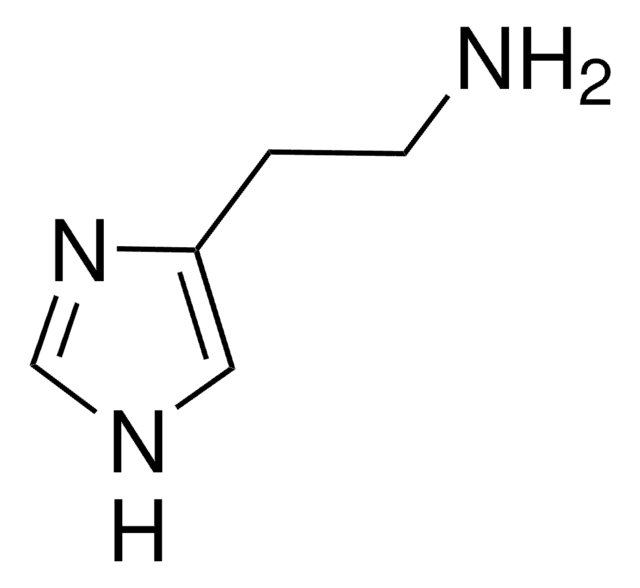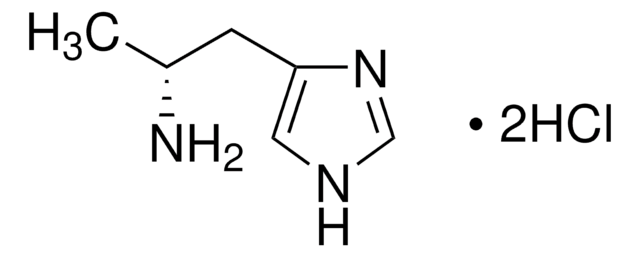Key Documents
H7250
Histamine dihydrochloride
≥99% (TLC), powder, endogenous histamine receptor agonist
Synonim(y):
2-(4-Imidazolyl)ethylamine dihydrochloride
About This Item
Polecane produkty
product name
Histamine dihydrochloride, ≥99% (TLC), powder
Poziom jakości
Próba
≥99% (TLC)
Postać
powder
kolor
white to off-white
mp
249-252 °C (lit.)
temp. przechowywania
2-8°C
ciąg SMILES
Cl[H].Cl[H].NCCc1c[nH]cn1
InChI
1S/C5H9N3.2ClH/c6-2-1-5-3-7-4-8-5;;/h3-4H,1-2,6H2,(H,7,8);2*1H
Klucz InChI
PPZMYIBUHIPZOS-UHFFFAOYSA-N
informacje o genach
human ... HRH1(3269) , HRH2(3274)
Szukasz podobnych produktów? Odwiedź Przewodnik dotyczący porównywania produktów
Opis ogólny
Zastosowanie
- as a orthograde cotransmitter in producing excitatory postsynaptic potential (EPSP)
- to determine its level in fish using HPLC (high performance liquid chromatography)
- to assess the tracheal response to antigens in guinea-pigs
Cechy i korzyści
Hasło ostrzegawcze
Danger
Zwroty wskazujące rodzaj zagrożenia
Zwroty wskazujące środki ostrożności
Klasyfikacja zagrożeń
Eye Irrit. 2 - Resp. Sens. 1 - Skin Irrit. 2 - Skin Sens. 1 - STOT SE 3
Organy docelowe
Respiratory system
Kod klasy składowania
11 - Combustible Solids
Klasa zagrożenia wodnego (WGK)
WGK 2
Temperatura zapłonu (°F)
Not applicable
Temperatura zapłonu (°C)
Not applicable
Środki ochrony indywidualnej
dust mask type N95 (US), Eyeshields, Faceshields, Gloves
Certyfikaty analizy (CoA)
Poszukaj Certyfikaty analizy (CoA), wpisując numer partii/serii produktów. Numery serii i partii można znaleźć na etykiecie produktu po słowach „seria” lub „partia”.
Masz już ten produkt?
Dokumenty związane z niedawno zakupionymi produktami zostały zamieszczone w Bibliotece dokumentów.
Klienci oglądali również te produkty
Nasz zespół naukowców ma doświadczenie we wszystkich obszarach badań, w tym w naukach przyrodniczych, materiałoznawstwie, syntezie chemicznej, chromatografii, analityce i wielu innych dziedzinach.
Skontaktuj się z zespołem ds. pomocy technicznej









